| St. Mary's |
Richard Lavallee Jan 2021 |
| Click photos to enlarge |
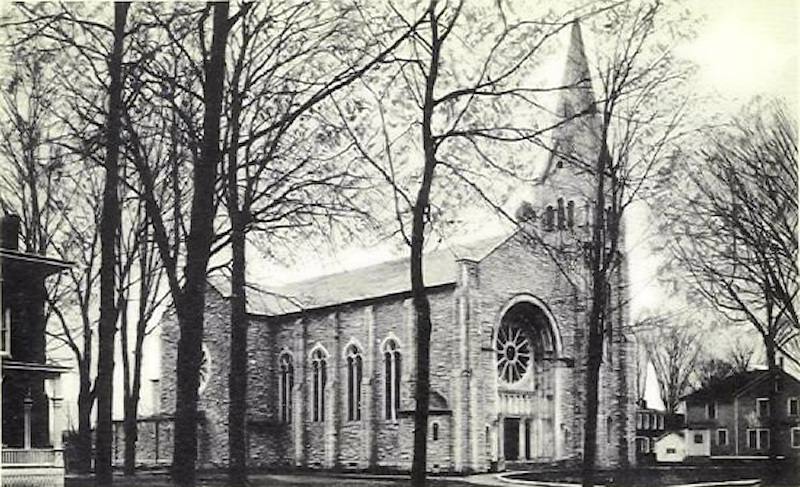 I
was a student at St. Mary School (St. Mary's) from 1st grade through 8th Grade,
from which I entered High School. St. Mary's is a Catholic school associated
with St. Mary's Church, which is the Catholic Church for the parish in Baldwinsville,
New York.
I
was a student at St. Mary School (St. Mary's) from 1st grade through 8th Grade,
from which I entered High School. St. Mary's is a Catholic school associated
with St. Mary's Church, which is the Catholic Church for the parish in Baldwinsville,
New York.
My description of St. Mary's church is based on what it looked
like in those days. Since then there have been interior changes. The
house on the right is on Downer Street, across the street from the house to
which my parents moved years later from Barbara Lane when my aging parents
needed to be closer to town.
The present-day church on Syracuse Street was completed in 1940. In
1949 I was baptized there by the pastor. He was from Luxemburg and his
name was Father Kirchen, which I find amusing since Kirche is German for "church",
so in English his name would be Father Church. I remember Father Kirchen
(barely) as a kindly older priest. He had spearheaded the construction
of the church in 1940, and later the school.
In my opinion St. Mary's is the most beautiful church in Baldwinsville, at
least from the outside, which is all I have to compare to the other churches
in town. It is a modified form of classic gothic architecture.
I am sure Father Kirchen wanted to emulate on a smaller scale the great gothic
cathedrals of Europe, which were the premier form of public architecture in
Europe during Medieval and Renaissance periods, and which, unlike palaces,
opera houses, and universities, were open to common people.
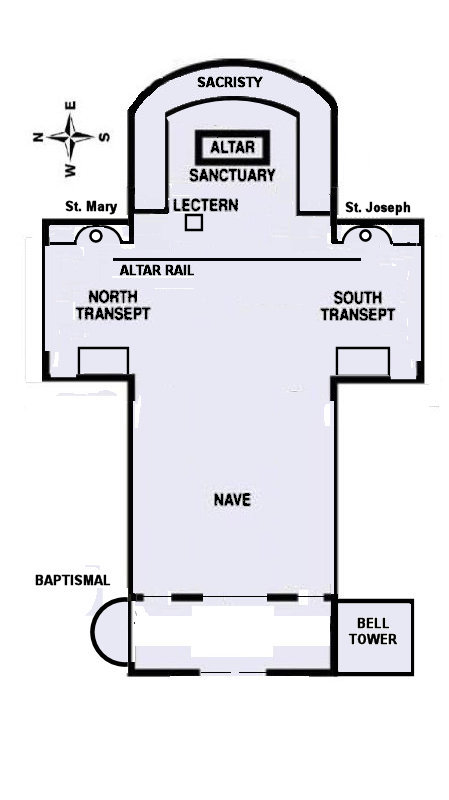 Like
all gothics, the church is tall and narrow, with a large bell tower and spire
at the front entrance, and a floor plan shaped like a cross, having the altar
and sacristy at the top of the cross, two side chambers forming the
transepts, and a long main body called the nave. The church
is tall to provide for tall stained glass windows for light to enter.
Like
all gothics, the church is tall and narrow, with a large bell tower and spire
at the front entrance, and a floor plan shaped like a cross, having the altar
and sacristy at the top of the cross, two side chambers forming the
transepts, and a long main body called the nave. The church
is tall to provide for tall stained glass windows for light to enter.
The exterior walls of St. Mary's are rough-cut light gray granite with particles
that sparkle in the sun. The main entry doors and the side transept
doors are light-colored oak. The roof is steep-pitched slate.
The interior of the church is magnificent. The floors are mosaic tile,
and the pews are dark oak. The walls have a black marble wainscot with
"lightning streaks" of pale greenish white. Between the tall
stained glass nave windows are half-columns with fancy fleur-de-lis capitals
supporting arched vaulted ceilings. Below each window is a relief sculpture
of the Stations of the Cross, as are found in every Catholic church.
A beautiful white marble altar rail separates the transepts from the sanctuary.
The rail is faced with inlays and relief sculptures of colored marble depicting
Christian symbols. Above the sanctuary is a massive proscenium
arch with large capital letters "ECCE EGO VENIO ET HABITABO IN MEDIO TUI",
which is Latin for Jesus saying "Behold, I come and live among you."
As a youngster I had no idea what it meant, and no one ever explained
it to me, but it looked very important. .
The sanctuary holds the white marble altar with its shining gold-domed tabernacle.
Above the altar is a large carved wooden crucifix with an ornate wood canopy.
Each transept has a statue, one of St. Mary, the other of St. Joseph.
In front of the statues are banks of red glass votive candles with wavering
flames. On the opposite side of the statues are the confessional booths.
At the entry, the vestibule had the baptismal font in a small
anteroom. Above the vestibule was the choir loft and an impressive
pipe organ. One time at a gathering some sort of I overheard the village's
Episcopal priest say that our organ "was worth more than my entire church".
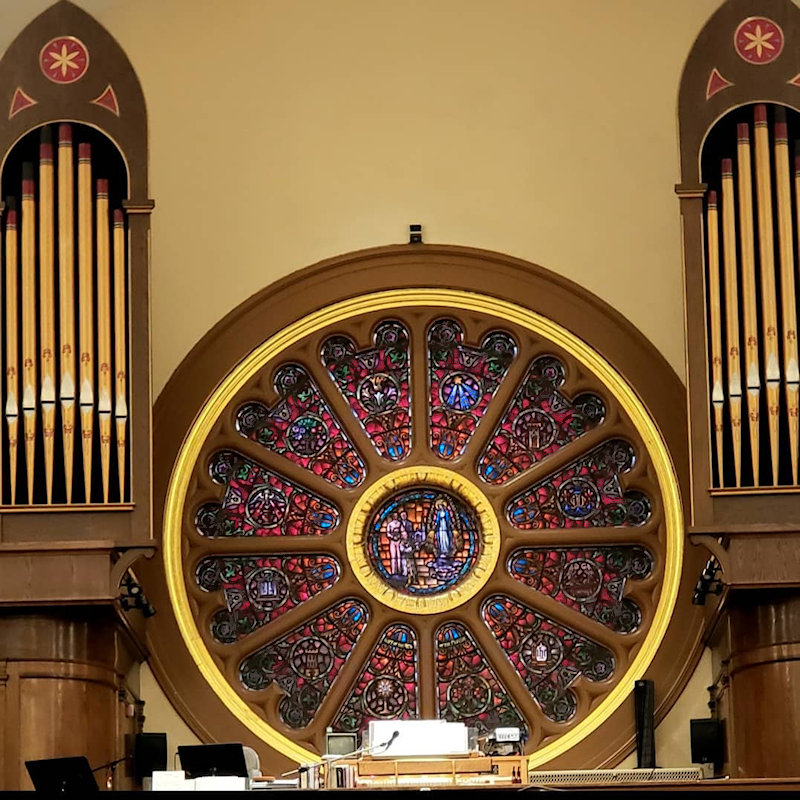 Our
family rarely attended Midnight Christmas Mass, but when we did, the organist,
who was a finicky fellow, would pull all the stops and hold forth with an organ
recital that blew the doors out. The bass notes would go straight through
my body and make the pews vibrate. There was nothing like it until I
was in college and I heard the opening organ solo by keyboardist Garth Hudson
of The Band on the recording Chest
Fever. (Put on the headphones) Christmas Midnight Mass was
where I began to love the power of the bass. That and the black
bass singers on early rock and toll songs.
Our
family rarely attended Midnight Christmas Mass, but when we did, the organist,
who was a finicky fellow, would pull all the stops and hold forth with an organ
recital that blew the doors out. The bass notes would go straight through
my body and make the pews vibrate. There was nothing like it until I
was in college and I heard the opening organ solo by keyboardist Garth Hudson
of The Band on the recording Chest
Fever. (Put on the headphones) Christmas Midnight Mass was
where I began to love the power of the bass. That and the black
bass singers on early rock and toll songs.
At the front entry and at the ends of each transept the church has large stained
glass Rose Windows. The rose windows are the crown jewels of St. Mary's.
They were imported from Luxemburg, the home country of the church's builder,
Father Kirchen. The largest, at the entrance, is unfortunately
only viewed when leaving the church, unless you're the priest or one of the
altar boys. The rose windows at each end of the transepts were
more visible. My favorite place to sit was in a transept, where I could
stare at the windows. The North transept window has the State Seal of
each of the thirteen original colonies, arranged like spokes, and the South
transept similarly has the crest of each of the thirteen counties of Luxembourg,
with strange German names like "Eschen". They look like Medieval
coats of arms. The glass elements of the windows are colored all the way through,
unlike tinted glass that has a tint applied to the surface. This
gives them a deep, rich color. The reds, blues, yellows and purples glow
like precious jewels. When the sun shines through it is a glorious sight.
St. Mary's is not the oldest church in Baldwinsville by any means. It
is pre-dated by the old Grace Episcopalian on Elizabeth street, one of the
first churches in America to have interior electric lighting, The Methodist
Church on W. Genessee Street street (Rt 370). the Baptist Church on Syracuse
Street, and the Presbyterian on Elizabeth Street are also forms of gothic style.
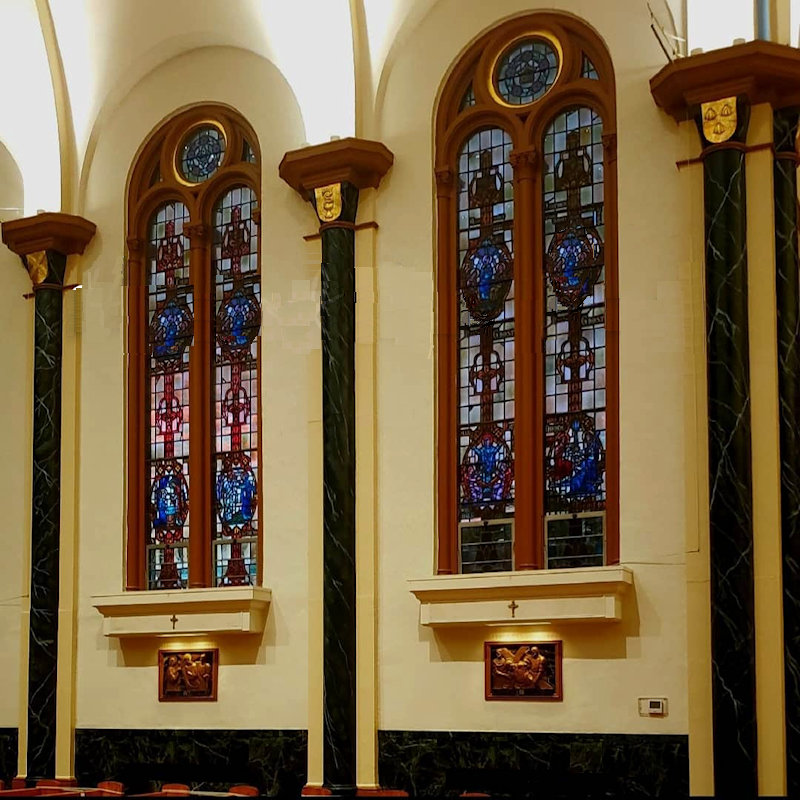 I
have some fond associations with the Presbyterian Church on Elizabeth Street,
a brown brick gothic-type structure with its own rose window. The Presbyterians
were the only people to invite me to talk about my trip to Germany.
They were a very supportive audience. The Presbyterians were also very
generous to allow our high school to use their school hall to hold our High
Cool dances at "The In". The Presbyterian school also
hired my sister Marilyn for her first job teaching little children after she
went to Auburn Community College.
I
have some fond associations with the Presbyterian Church on Elizabeth Street,
a brown brick gothic-type structure with its own rose window. The Presbyterians
were the only people to invite me to talk about my trip to Germany.
They were a very supportive audience. The Presbyterians were also very
generous to allow our high school to use their school hall to hold our High
Cool dances at "The In". The Presbyterian school also
hired my sister Marilyn for her first job teaching little children after she
went to Auburn Community College.
Our family went to church every Sunday, although I don't remember going to
church until I was in St. Mary's School. We all got dressed up in our
"Sunday best", as everyone did, and piled into the station wagon
for the short trip to Baldwinsville. We always sat in the
same pew about 1/2 of the way back from the altar rail. On the
back of the pew in front of us were little spring clips for holding your hat.
At one time people could "reserve their spot" with a donation, so
there were little name tags on the hat-holders. Ours had someone named
Bochino on one of the hat holders. We sat right behind the Peach family
- Karen Peach was my classmate.
Church lasted about an hour, and it was mostly drudgery with all the sitting,
standing and kneeling. If my back hurt from carrying newspapers it was
particularly uncomfortable to kneel for a long time. There wasn't
any singing in those days except for the choir. Later on they started singing,
but Catholics are really inhibited singers. Not much spirit.
I was usually in between my older brother and my brother Gary, and neither
of them could carry a tune, so it was a battle for me to stay focused.
Sometimes if I stared at one spot in the altar area for a long
time things would start getting all hazy like a kaleidoscope and the little
pieces of light would start moving around, but any movement of my eyes would
break the spell. I could also stare at the lightning bolts in the black
granite and daydream. I was always glad when it was over and I could move around
and get my body in a comfortable position again.
In my early years the Mass was conducted almost entirely in Latin, a practice
dating back about 1,500 years. After years of repetition, the Latin phrases
could be understood, especially if you had a prayer book, or missal,
with a translation. When I was in 8th grade in 1962, the reforms inaugurated
by Pope John XXIII began with parts of the Mass being recited in English instead
of Latin. But for my time at St. Mary's, the Mass was in Latin.
The 11 o'clock Mass was the High Mass and they had our excellent choir singing
and the organ playing, but we almost never went to that one. It lasted longer,
and Mom had to get home to start making Sunday dinner. We always went
to the 9:30 Mass. If we went to the 11 o'clock we had to sit way
in the back. I think the Super Catholics went to the 11 o'clock,
and the 9:30 was more for the regular Catholics.
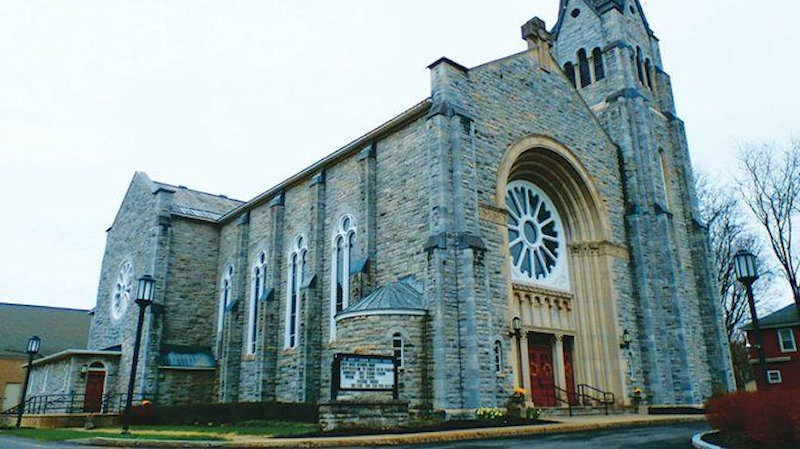 My
father was a very pious Catholic. His forebears were French Canadian;
my Grandfather, Henry Napoleon Lavallee, having emigrated to the US as a young
man. He had studied for the priesthood but gave it up and became a farmer
instead. French Catholics seem to have two schools of thought on religion.
My father belonged to the school that was rather Calvinist - party in
private, pray in public. Lots of guilt and suffering, not much joy.
Prudish, yet enthusiastic in following the command to be fruitful and multiply.
(Eight kids, for heaven's sake. Literally) .
My
father was a very pious Catholic. His forebears were French Canadian;
my Grandfather, Henry Napoleon Lavallee, having emigrated to the US as a young
man. He had studied for the priesthood but gave it up and became a farmer
instead. French Catholics seem to have two schools of thought on religion.
My father belonged to the school that was rather Calvinist - party in
private, pray in public. Lots of guilt and suffering, not much joy.
Prudish, yet enthusiastic in following the command to be fruitful and multiply.
(Eight kids, for heaven's sake. Literally) .
My Aunt Rhada, wife of my dear Uncle Claude, was more from the other school
of French Catholics. Happy, winking, naughty, laughter, devil-may-care.
Let's face it. When your living depends on bulls humping cows, there's
no point in pretending these things don't happen. My farmer cousins were
way ahead of me in the birds-and-bees department.
My mother was a convert to Catholicism. Her parents were Black Methodist.
"Black" from wearing black, plain clothing. Outwardly rather puritanical. No
dancing, no alcohol. My dear Grandma never touched a drop.
Teetotaler, although I understand one time someone slipped her a bit of wine. Sober,
but not severe. My Grandma was not in the least severe, she was clever and
funny. Nor was my Grandpa Magoon. He was just the quietest man
I have ever known. Nevertheless it's my understanding
that my Mom's conversion to Catholicism practically got her disowned from her
family, even though my Catholic Dad and his Protestant father-in-law had a
very good relationship.
Religion and politics were that way. You could be cordial to the opposite
camp, but there were lines that were not crossed - like getting married to
one of them. As happens many times, the arrival of grandchildren softens
the prejudices. It's hard to be prejudiced toward an innocent little
baby, .especially your own blood. When my older brother was
born, my mother fell into a deep depression, and my Grandmother and my Aunt
Janet and Aunt Lois helped to take care of him while my Mom rested.
There was still some anti-Catholic sentiment in America, going way back to
the days when Irish and Italian immigrants had flooded into the United States.
My family had been here for 200 years before the 1850s flood of immigrants,
but no matter. Catholics were supposedly low class, dirty ruffians.
Fortunately for me, things grew more civilized, especially with the arrival
of Pope John XXIII in the late 1950s and his sincere efforts to bring
together the believers in the message of Jesus Christ - a message of love for
one another, and tolerance for what are essentially little quibbles over the
decor and the song list.
Father Kirchen either retired or passed away shortly after I started school.
There may have been a temporary priest in between, but in any event not long
after we had a new pastor. Monsignor Daley, and he had an assistant priest,
Father Kelly. With all the Baby Boomers, things were growing and they
needed two priests.
A Monsignor is a rank in between a parish priest and a bishop, so our parish
was getting a promotion with Monsignor Daley. He was from
money. He drove a Mercedes coupe. He was tall, and he looked a
bit like Charles DeGaulle. The haughtiness. Prominent nose - down
which he looked with slightly closed eyelids and a slightly arched eyebrow.
When Monsignor Daley gave a sermon the whole parish's vocabulary
got kicked up a notch. He was very intelligent and well educated.
The word was he spoke seven languages, and he taught occasionally at university. (As
a matter of fact, years later when I was at Syracuse University he showed up
to teach a lecture at which I was in the audience.)
Monsignor Daley was not one to suffer fools. He wasn't mean, but he
wasn't kindly either. His sermons got your attention right off the bat,
and they were either high-toned theological lectures or a polite but stern
beating the bushes for money. The heating bills for that church!
No theatrics, no "fire and brimstone", just ice-cold reasoning.
He would not hesitate to shame a mother into removing a crying baby,
or if a woman showed up in shorts or without head covering, it would be
the last time. There were occasions when a woman forgot her hat
and she would have a handkerchief pinned to her hair. Poor thing.
Shortly after his arrival, Monsignor Daley wanted to put his personal stamp
on the church, so he ordered up a fancy decorating scheme that added gold leaf
climbing vines and fleur-de-lis on the columns, and a general prettifying of
the place that I found rather overindulgent. Literally, a gilding-of-the-lily.
(Many years later another drastic and in my opinion ill-conceived remodeling
occurred that removed the beautiful altar rail and rendered the sanctuary/altar
chamber superfluous).
I dreaded going to Confession with Monsignor Daley, but if Father Kelley's
side was too full that's where we'd wind up. Father Kelley's side always
had more people at Confession because he was a kind young man. He was
tall and slim with dark hair, pleasant looking and easy-going. By the
time I was a junior in High School they added a third priest - Father Pompei
. He was a short, round little Italian fellow, and he would hear
confession, not in one of the two booths, but in the center of the altar rail.
This was almost as bad as Monsignor Daley because you were out in the open
and everyone could see you, and of course you're thinking they must be able
to imagine all the horrible things you've been up to. I absolutely hated
Confession on Saturday but my father would drag us down every week. After
I got to college there were only two occasions on which I went to Confession,
one infamous instance that I speak of in My
Woodstock Story, and another covering the the same subject with Father
Pompei when I was back in Baldwinsville on a break from college. That
was the end of it.
St. Mary School
Once again I arrived at school with a little name tag pinned to
my coat. It was 1955, my first day, First Grade at St. Mary's. I was the first
of my siblings to go to St. Mary's. If I recall correctly, when the school
was opened they didn't yet teach all 8 grades, and my older brother was already
in 5th grade at Elizabeth St. School, so he stayed there. My brother
Gary would start behind me the next year, and my sister Marilyn would follow
a couple of grades after Gary.
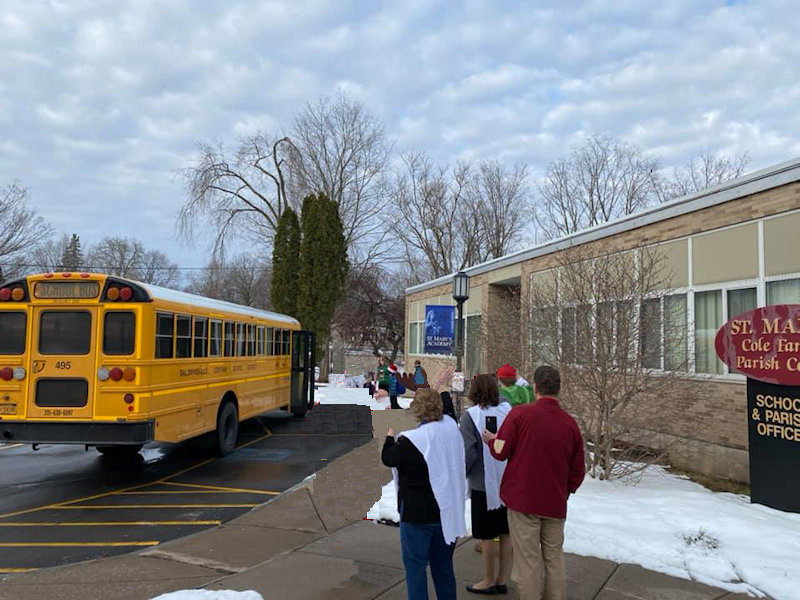 St. Mary's was completed in 1952, only three years before I started.
. The school was a tan multicolor brick with a flat roof. It was
a "split-level", but with a common flat roof line. The front
was one story, facing the back of the Church, and the back side was two stories
high set into a slope, so that the school's roof was all one level. .
The one-story front side was for the younger grades - 1, 2, and 3. The
back side was for grades 4, and 5 on the top floor 6 and 7 on the bottom floor.
For some reason in the 8th grade we recycled back up to the 1st floor classroom
that we had in 3rd grade. It's possible that our elderly 8th grade
teacher was having difficulty managing stairs. There were a couple
of spare classrooms that might have been used for Religious Instruction of
the public school kids. I'm not sure. Also one of the spares was
where Monsignor Daley gave us "The Talk" in 7th or 8th grade.
St. Mary's was completed in 1952, only three years before I started.
. The school was a tan multicolor brick with a flat roof. It was
a "split-level", but with a common flat roof line. The front
was one story, facing the back of the Church, and the back side was two stories
high set into a slope, so that the school's roof was all one level. .
The one-story front side was for the younger grades - 1, 2, and 3. The
back side was for grades 4, and 5 on the top floor 6 and 7 on the bottom floor.
For some reason in the 8th grade we recycled back up to the 1st floor classroom
that we had in 3rd grade. It's possible that our elderly 8th grade
teacher was having difficulty managing stairs. There were a couple
of spare classrooms that might have been used for Religious Instruction of
the public school kids. I'm not sure. Also one of the spares was
where Monsignor Daley gave us "The Talk" in 7th or 8th grade.
The classrooms had metal desks with a wooden lid that you could lift up and
stow your stuff in the metal tub below. The seats were connected to the
desk so you couldn't shift them around. The classrooms
had a wall of windows, with the top and bottom windows hinged to open for fresh
air. The top window was so high up that the nuns had a long pole with
a hook on the end that they could hook into a ring on the top window and unlatch
and drag it open when we had hot days . The teacher had a big oak desk
and there was a long slate blackboard at the front of the classroom.
The school had a gymnasium and below it a cafeteria where I had hot lunch
every day. Lunch money was only 25 cents. There
was no way my Mom was making sandwiches for so many of us kids. The cook
was a very nice older lady named Mrs. Carter and she had a helper lady.
When I was in 7th grade Mrs Carter's helper lady was Mrs. Viau - my next
door neighbor and the wife of the man who had saved
my life - Milton Viau. Their son Charley was one grade ahead of me. In
7th grade Mrs. Viau brought me along early with her before school started so
I could attend a special class where Mrs. Bochino taught a few of us French.
Mrs. Viau had an old car that wouldn't start in the cold without a lot of coaxing.
One day Monsignor Daley stopped by and heard me speak French, and
he told Mrs. Bochino (in French, thinking I wouldn't understand), that I had
a French Canadian accent. I thought this was rather ridiculous as I had
never really heard French Canadian speech. Where would I have picked
up an accent? Although the Viau family came from Canada, they spoke heavily
accented English. Charley would say "I washed my hands in the zinc"
instead of "sink". but he soon lost his accent.
One day Mrs. Viau informed me that should not take me in early any longer
because her insurance company wouldn't let her take regular passengers.
I was greatly disappointed.
These days I believe Mrs. Carter and her helper were like the Bible story
of the loaves and fish sticks. How she could prepare hot
meals every day for hundreds of kids astounds me now. One of my
favorites then and today was tomato soup and grilled cheese sandwiches.
.Once in a while we would have Boston Cream Pie - two layers of cake separated
by a layer of vanilla pudding and topped with chocolate frosting. A few
boys didn't like it, which surprised me, and they would give me their piece
of cake. I would eat two or three of them and then waddle out to the
playground.
Mr. Blair was our janitor. He was a slender, grey-haired man who
never spoke. He kept the school spic-and-span and could occasionally
be seen heading into the rest room with his bucket of pink sawdust cleaning
up after some kid's vomit. Little kids tend to vomit quite
a bit. In time he had a helper whose name I can't remember. He
was from Poland and spoke very little if any English but he seemed like a cheerful
man. .
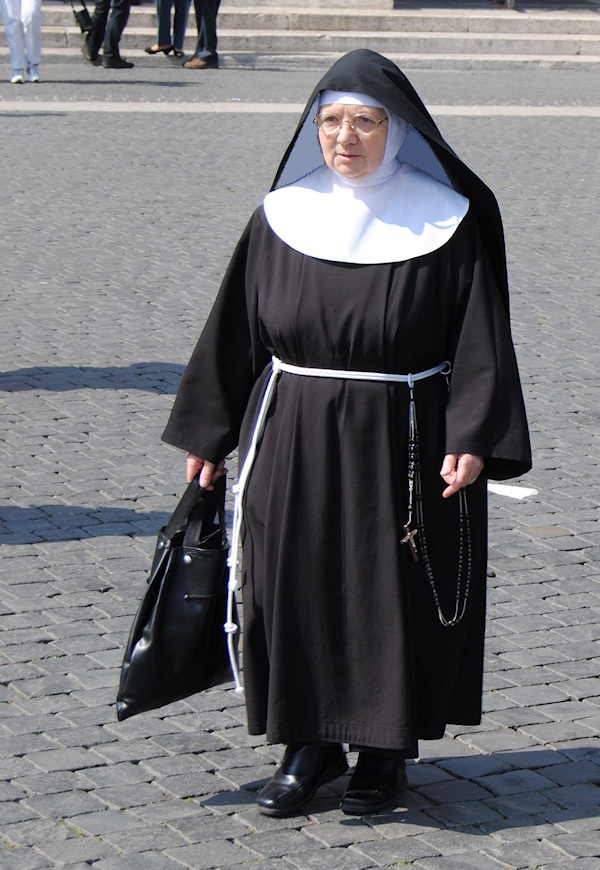 Our
teachers were all nuns of the Order of St. Francis, or Franciscan. Their
costume is called a habit, and in those days it was long black
tunic with a white cord or a large-beaded rosary around the waist,
a black head veil lined with white underveil, a stiff white
crown band that covered the forehead, a white coif
that covered the neck and the ears, and a stiff curved wimple that
covered the shoulders and the chest. The only visible part of the nun
was her face from the eyebrows to the chin, and her hands. The
habit emulates the clothing that women wore at the time of Jesus.
Our
teachers were all nuns of the Order of St. Francis, or Franciscan. Their
costume is called a habit, and in those days it was long black
tunic with a white cord or a large-beaded rosary around the waist,
a black head veil lined with white underveil, a stiff white
crown band that covered the forehead, a white coif
that covered the neck and the ears, and a stiff curved wimple that
covered the shoulders and the chest. The only visible part of the nun
was her face from the eyebrows to the chin, and her hands. The
habit emulates the clothing that women wore at the time of Jesus.
Our Sisters had little formal training as teachers. Some were so young
they were barely out of high school, which is how things were when public schools
became widespread in the 1800s. In rural areas the smartest high school
girl after graduation would become the teacher if need be. I believe
that is the way that my own Grandmother Magoon had become a teacher.
The Sisters had a good High School education, which was furthered by their
training as they prepared for their life of service. Some of them were
very good teachers, and all were at least competent in teaching the basics
of Reading, Writing, and Arithmetic. In addition, many of our Sisters
had decades of experience in teaching young children.
In the process of becoming a nun, the Sisters took vows of Poverty, Chastity,
and Obedience. They had no possessions, nothing to clutter up their
life. They gave up life with a husband and children. We were their
children in some respects, although we called them Sister, not Mother.
Mother Superior was a title reserved for the chief nun in a convent that is
training young nuns. The Sisters are obedient to the rules of their
order, to the bishop of their diocese, and to the pastor of the parish which
they served. Individuality was somewhat discouraged, but there
was no way to suppress their basic personality, which could be delightful.
The Sisters gave up many of the things of our lives, but in return they
had a life of simplicity, peacefulness, and devotion.
First Grade - Sister Mary Justus. Naturally one shouldn't
expect things to be as easy-going and informal as kindergarten had been.
School lasted "all day". We took the bus with the older kids and
transferred at Elizabeth Street school to continue on to St. Mary's
Our chairs were arranged in rows, there was no nap time, but we had recess. My
favorite playground friends were Larry Cummings, who lived right next to the
school grounds, and Harry Hayduke, both of whom would continue all the way
through 8th grade. Our playground was in front of the school in the
parking lot, whereas the upper grades used the back parking lot.
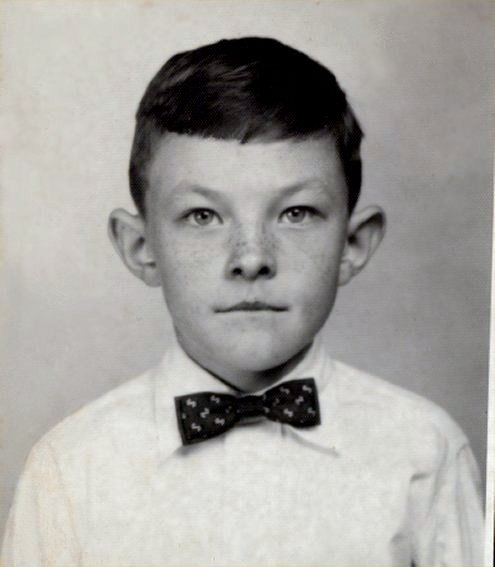 The
day was divided into lessons. One day Sister Justus brought out
our first reading book. She was an older nun. It was the familiar
story of Dick, Jane, and Spot. She had us read out loud a sentence
or two. When it got to my turn I just kept on reading through the whole
book because I already knew how to read. Sister Justus was a bit
taken aback, and she brought out all seven of the books that were were going
to cover for the year, I think, and I read through all of them one by one.
So I guess I was done reading for the year.
The
day was divided into lessons. One day Sister Justus brought out
our first reading book. She was an older nun. It was the familiar
story of Dick, Jane, and Spot. She had us read out loud a sentence
or two. When it got to my turn I just kept on reading through the whole
book because I already knew how to read. Sister Justus was a bit
taken aback, and she brought out all seven of the books that were were going
to cover for the year, I think, and I read through all of them one by one.
So I guess I was done reading for the year.
Another time Sister decided to "play store" and she brought me to
the front of the room beside her desk. She was the customer, and
I was the storekeeper. She pretended to buy something, and she handed
me a play money dollar bill and told me to make change. I had no
idea what she meant, I had never been in a store or seen a cash register.
My parents did all the shopping and left me in the care of my older brother
for as long as I could remember.
Once again Sister demanded that I "make change", and again I stood
there frozen, having no idea what that meant. Sister Justus slapped
me hard across the face. I began to cry. It was time
to go to lunch, and Sister Justus lined everyone up and proceeded to leave
the room, but she stuck me in the spare classroom next door and sternly told
me I could not come out until I stopped crying. I managed
to stifle my sobbing and wipe my tears, and she let me come out.
Like many American families, my parents acquired a set of books for our home
that would stand me very well through Grade School. Our set was published
by the Grolier Society, and it included the Encyclopedia Americana (a counterpart
to the Britannica). The Encyclopedia would come in handy for High School reports.
The set also included the Book of Knowledge, which had Fairy Tales,
Poems, Fables, condensed Novels, stories, and history; and the Books of Popular
Science, which had all sorts of scenic articles. My favorites were
the Book of Knowledge and the Book of Popular Science. They had about
12 volumes each, and I read them over and over through our long winters. .
Second Grade - Sister Catherine. Unlike Sister Justus,
who was on the heavy side, Sister Catherine was skin and bones. It seemed like
there was a little space between her coif and her face She was
trim and rather agile, and could pounce out of nowhere, as she did when she
caught me erasing one of my answers on a test, and whacked me sharply across
the knuckles with a wooden yardstick. There were already two broken yardsticks
in the waste can at the back of the room.
This was a year of terror. One day I was sitting a row or
two behind Fred Gaske, and I looked under his seat and saw a puddle of urine.
He was too afraid to ask to go to the restroom. The same
thing happened later to poor Simone Miller, and Sister Catherine called her
up to the front of the class and demanded an explanation. I think
Sister Catherine had it in for Simone, because she had worn little gold ear
piercings that Sister Catherine had made a big show of demanding that she no
longer wear to school. Simone was a pretty blond girl who looked just
like her older sister a couple of grades ahead of us, even prettier, who also
had the same kind of ear piercings. If I'm not mistaken I think her parents
had fought back and refused to remove the ear piercings.
Second grade we also started learning the Palmer Method of writing in longhand,
or cursive as it's called today. I was a disaster at longhand.
My small muscle coordination has always been poor. No matter how I tried
I could not make the perfect coils and up-and-down strokes. Some
people think I'm a doctor because my handwriting is so illegible. So
I print instead.
Sister Catherine called me "John" the entire year because she had
once had a pupil named John Lavallee. I never corrected her. In
some respects it was like I had an alias and her ire was being directed at
someone else and not me.
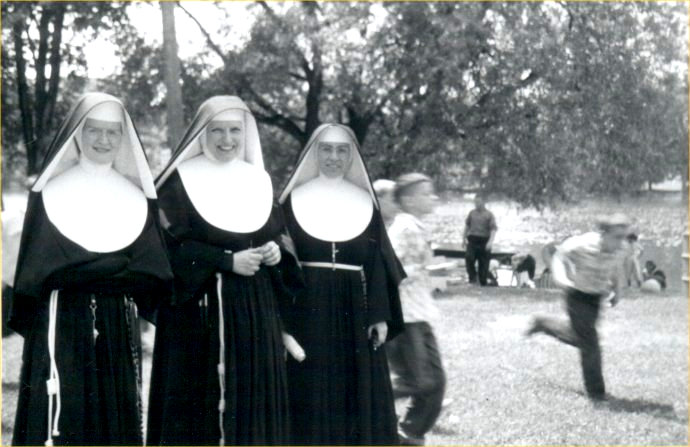 Third Grade - Sister Lenore .Sister Lenore was short
and very quiet. Her skin was darker, I think she may have
been Filipina, unlike Sister Catherine, who was as white as a sheet. I
remember very little of her year, as nothing really bad happened. It
was like an oasis of tranquility after a stormy crossing of heavy seas.
We started learning multiplication tables.
Third Grade - Sister Lenore .Sister Lenore was short
and very quiet. Her skin was darker, I think she may have
been Filipina, unlike Sister Catherine, who was as white as a sheet. I
remember very little of her year, as nothing really bad happened. It
was like an oasis of tranquility after a stormy crossing of heavy seas.
We started learning multiplication tables.
I believe that 3rd grade was the first time we got lined up to get a shot
in the arm of polio vaccine. We all went to the gym in a line and got
the shot in turn. I remember Laurene Kelly, because she was the tallest
in the class, looking rather grim , stiff upper lip, but with incipient tears,
waiting in line after I had gotten the jab. She seemed determined not
to break down. Good show.
Picnic Day. Sisters Catherine, Adele, Lenore
Fourth Grade - Sister Emmett Frances Sister
Emmett Frances was from Canada. She was a farm girl, which I connected
with my mother and her family. She was very young, and she had an ever-present
smile. She was a benevolent young woman even though her youth
was somewhat disguised by her clothing . It was only years later that
I found out how very young she had been. I soon developed a big crush
on Sister. There was nothing I would do that could possibly displease
her.
In 4th grade we learned "long division", which up until then had
been a scary word. Nothing to fear here. What I was
really afraid of was what was coming next year in 5h grade.
Sister Mary Bernard, a tall, imposing woman with a deep voice who
was a known terror throughout the school. Whenever I saw her in the hallway
it looked like she was getting ready to dispense justice.
Fifth Grade - Sister Emmett Frances A miracle occurred
For some unknown reason, when we started 5th grade, there was Sister Emmett
Frances once again. Sister Mary Bernard was gone. My heart was full
of joy. . I can only imagine I must have flirted shamelessly and
Sister could only bite her tongue to keep from laughing out loud.
One day all the Sisters got a shipment of new habits and they were all excited,
During lunch recess they unpacked and tried them on as we were out playing,
and I was fantasizing being in the room watching them change their clothes.
Well, the pretty ones anyway.
Sister Emmett Frances gave me the great honor of making me Captain of the
Safety Patrol. I was supposed to keep kids from hurting themselves,
but what it amounted to mostly was watching the stairway to keep kids from
sliding down the banister, which was great fun. It was a a double banister,
with one rail at butt height and another that fit right under your armpit.
The rails were varnished wood, nice and slippery. With a good
head start you could get a nice speedy run that would almost launch you through
the double doors that led to the playground. Now I had to keep kids from
doing it.
Safety Patrolmen had a white shoulder/waist belt and a silver badge.
I would take the belt home at night and scrub it with Comet to keep it snow
white. Sometimes I think I was made Safety Patrol to get me out of the
classroom, as I was becoming something of a Smarty-Pants. It wasn't doing
anything for my popularity, for certain.
I really went overboard. I had to keep a little journal in which I
was supposed to log infractions, but I never did much, except one time I wrote
a critique of my partner Pete Young's inattention. Then Sister Emmett
Frances rotated Captains and made Pete Young Captain, and when Captain rotated
back to me I read in the log Pete's response to my critique, and I saw
that I had hurt his feelings with what I had written. I was mortified
Being Safety Patrol gave me the opportunity to play Spy. When
classes were in session I could roam the corridors and hide in little nooks
and other hiding places and avoid detection by Mr. Blair the janitor or by
a Sister who had occasion to leave the classroom for something. It was
great fun. Plus I could take a few runs down the banister myself.
Our school added a library in one of the spare classrooms downstairs. and
that is where I discovered The Leatherstocking Tales by James Fenimore Cooper,
for whom Cooperstown is named. The Leatherstocking Tales is a series
of novels including The Last of The Mohicans, The Pathfinder, and others.
They are set in the forests of Central New York, my forests. Cooper's
books brought me and my brother Gary into the world of Natty Bumppo the
Deerslayer and Chingachgook the Last of the Mohicans. and I was with
them in our forests. Years later I brought my family to Cooperstown,
to the Baseball Hall of Fame, but also to Cooper's big mansion by the lake,
where the long sloping meadow brings you to a living history museum of an Iroquois
Long House and a family of enactors explaining their life in the forest.
One Spring day I volunteered to clap the erasers and clean the blackboard
after school, and when I was finished it dawned on me that I had thereby missed
the bus home. I was in a bit of a panic, but Sister Emmett
Frances let me know that she could write a note to get me on the 4:15 bus that
took high school kids who had clubs or sports. It meant I would have
to walk through town to get up to the High School. She opened her
desk drawer and I could see she had a little picture of a lifeless Jesus being
taken down from the cross. I was a bit startled by the picture.
It was not the typical depiction of his emaciated form. Jesus was very
muscular, and his loin cloth covering was barely draped over him. I was
rather shocked. She began my note "To whom it may concern.
Please allow Richard Lavallee to take the late bus home"
Which I did.
Sixth Grade - Sister Adele Sister Adele
had a pretty face, a very nice smile, and lots of personality.
She told us how her father had tried to discourage her from joining the convent,
and had promised her a brand new Thunderbird car if she didn't become a nun.
Sister Adele was very easy-going, which Pete Young and I took advantage of
by sitting way in the back of the class on opposite sides of the room and constantly
whispering back and forth and cutting up when her back was turned. Pete
Young was my Go-To Guy for shenanigans, even in High School.
Finally Sister Adele had had enough, but all she did was tell the class how
some people wait until your back is turned to create mischief, and I knew she
was on to me & Pete. After which she moved me to the front row so
I could no longer misbehave with Peter. I was really uncomfortable with
everyone staring at the back of my head, or so it seemed. I always want
my back to the wall whenever I am in a crowd. That may be where it started.
Up until this time I had always been the fastest runner in my class.
I always got off to a good start, and running through the fields and woods
at home made me a good runner. But now some of the boys were growing
longer legs, and Dave Clement and Dick Cahill were able to beat me ion foot
races. Now when I see the Seinfeld episode about his foot race with his
old rival I get a laugh. But he cheated.
The nuns were very good at teaching English, Spelling, Arithmetic,
and History, but they were weak in Science, and the school made no attempt
to offer any 9th Grade material like Algebra or BIology. Perhaps they recognized
this , and Sister Adele one day produced a "Science Kit" and asked
to see what I could do with it. It had an alcohol burner for chemistry
and some other stuff, and I read the manual with suggested experiments.
I thought I would keep things simple and construct a water filter that used
a tall cylindrical beaker and sand to show how water could be filtered through
layers of sand. I put it all together, and for the demonstration
I poured some muddy water in the top of the beaker and let it percolate though
the sand, but all I got at the bottom was muddy water. What
an embarrassing mess. I tried a few other things with the Science Kit
but I was not able to get much success. Things were not any
better in college when I took Chemistry and my labs would result in nothing
but gray sludge.
 I
got picked to go on a special trip with kids from other schools to visit the
State Capital in Albany. I had to get up very early to get on a
bus and travel to the Capital, were we were greeted by some adults who took
us all around the beautiful building which is built in a Dutch Baroque style,
much like the City Hall in Bremen that I would visit a few years later at the
end of my trip to Germany. The ornate
halls were even richer and more opulent than our church. We got to sit
in the gallery during an Assembly session and watch politicians giving a speech. Then
we went to a natural history museum where there were life-size dioramas of
Indians and forest animals. At the end of the day we had a bunch of pamphlets
and reading material. When I got back to school I gave a little report
on my trip.
I
got picked to go on a special trip with kids from other schools to visit the
State Capital in Albany. I had to get up very early to get on a
bus and travel to the Capital, were we were greeted by some adults who took
us all around the beautiful building which is built in a Dutch Baroque style,
much like the City Hall in Bremen that I would visit a few years later at the
end of my trip to Germany. The ornate
halls were even richer and more opulent than our church. We got to sit
in the gallery during an Assembly session and watch politicians giving a speech. Then
we went to a natural history museum where there were life-size dioramas of
Indians and forest animals. At the end of the day we had a bunch of pamphlets
and reading material. When I got back to school I gave a little report
on my trip.
NY State Capital Albany Interior
Sister Adele was very musical, and one day out of the blue she said "Let's
do a show", just like Judy Garland in one of the old Andy Hardy movies.
She had a whole script laid out with the whole class participating.
It was set up like a vaudeville minstrel show. Fred Gaske was the mayor
of the town. Larry Cummings and I were minstrels with overalls,
straw hats and blackface, which of course would never be allowed today.
We even had a black stocking pulled over our head to hide our hair, with
a cutout for our face. The class sang songs and there was a little story,
and Rick and I danced around in front of the singers at the appropriate time.
Choreography! We put the show on in front of the entire school
in the gymnasium, and our village newspaper came and did a story,
with pictures.
(Of course my role in blackface meant I could never run for political office,
but there were plenty of other circumstances that would also get in the way
in the unlikely event I I ever had an intention of being a politician.)
Sister Mary Stephen The minute we walked into
Sister Stephen's classroom for the first time , we knew that the shenanigans
were over. She had an ice-cold look and a tone that was all business.
No more fooling around. Sister Stephen was not mean.
She was the most intelligent of all the Sisters I had in St. Mary's.
She had a sense of history. She was from Ireland and her brothers had
been involved in the Irish Uprisings against the British and she told us stories
about their horrible treatment.
She also had a sense of fun. She made up games to help us learn, like
Spelling Baseball. She was the pitcher, there were teams.
and correct spelling advanced you to first base, and then your team had to
help you around the diamond. It was fun.
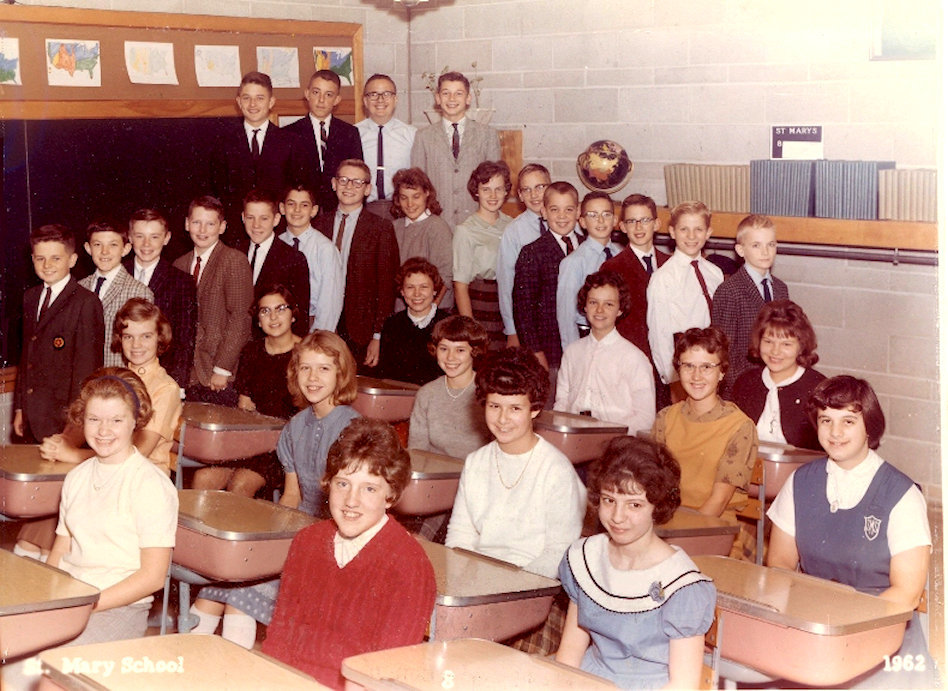 Later
in the year our Principal, Sister Louis, came up to me and asked if I would
like to be in a Diocese Spelling Bee in Syracuse. (A Diocese is a group
of parishes that is headed by the Bishop). Of course I was happy
to participate. She said I would be up against stiff competition among
much bigger schools. She tested me with a few words. I misspelled
"inveigle" , a word I'd never seen before, thinking it was spelled
"invagle", the way it sounded. I went to the big spelling bee
and got knocked out in the first round with another mysterious word.
Oh well. I was a good speller because I read a lot, but spelling bee
champs are kids who memorize the dictionary.
Later
in the year our Principal, Sister Louis, came up to me and asked if I would
like to be in a Diocese Spelling Bee in Syracuse. (A Diocese is a group
of parishes that is headed by the Bishop). Of course I was happy
to participate. She said I would be up against stiff competition among
much bigger schools. She tested me with a few words. I misspelled
"inveigle" , a word I'd never seen before, thinking it was spelled
"invagle", the way it sounded. I went to the big spelling bee
and got knocked out in the first round with another mysterious word.
Oh well. I was a good speller because I read a lot, but spelling bee
champs are kids who memorize the dictionary.
One time Sister Stephen decided to have a history contest between me and Fred
Gaske, who was the best history student in our class. Fred would go on
to major in History at Syracuse University, where we were pals and had adventures
together, and then went on to become the State Historian for the State of Florida!
Fred is one the only classmate of mine to go all the way from
Kindergarten through college together
The rules of the contest were that the contestant who recited the most sentences
on the historical topic won the game. I knew Fred was going to be tough
to beat, so I had to strategize. Sister Stephen gave me the first choice
of topic, and I knew that Fred was a huge Civil War buff, so I picked the Civil
War, and Fred had to settle for the Second World War for his choice of topic.
I had earlier read massive Civil War books in the Village Library on my own.
but for the contest I turned to our trusty set of books at home. The
Book of Knowledge had a lengthy treatment on the Civil War, so I read it through
the night before and practically memorized it. The day of
the contest I went first. I rattled off a ton of sentences, keeping them
short so there would be more of them. A couple of students were keeping count.
I covered the whole war from start to finish. Then Fred came
up and covered the history of the Second World War, but I won the contest.
That was the only time I would ever get the better of Fred in history.
He's a master. State Historian of Florida!
Another time Sister Stephen decided to give the class a lesson in common sense.
There was an illustrated page on the wall near the classroom door. Sister
asked me to come up and she gave me another page and asked me to put it over
the first page. I fastened it on the wall such that it covered
over the one that was already there. Then she called on Margaret Steves
and asked her to correct what I had done. Margaret went over and
removed the page I had put on top of the original, and she fastened it over
the first page, so that it was higher up the wall, and both were now visible.
The implication was that I, being a smart boy, lacked common sense. Fair
enough.
I was mortified. I suppose my confusion could have been cleared up if
she had said above instead of over
, but never mind semantics. I felt as though I had been tricked.
I sat silent, and I could feel my face turning as red as a beet. Sister
Stephen took notice , and she said something along the lines of sometimes it's
better to let things out, but I wasn't going to make things worse by blurting
something out. It took a long time before I choked down my pride.
I suppose I deserved a comeuppance. I had gotten used to thinking I was
the kid with all the answers.
Many years later when I was in college I happened to be in the parking lot
at the church, and there was Sister Stephen surrounded by a bunch of kids.
I was shocked to see her, thinking she must have long since retired.
She recognized me, but she was busy with the children and we didn't speak.
It was a very pleasant feeling seeing her in good health after so many years
had passed.
Sister Mary Louis (Lewis?)
We had arrived at 8th grade, our last year at St. Mary's. Now we were
the older kids who served as an example for the youngsters, and most of our
shenanigans were a thing of the past. Sister Louis was elderly
and quite frail. She was the principal of the school, but
no one ever got sent to the principal's office because she was the teacher
in our classroom. No one wanted to upset the old lady. .
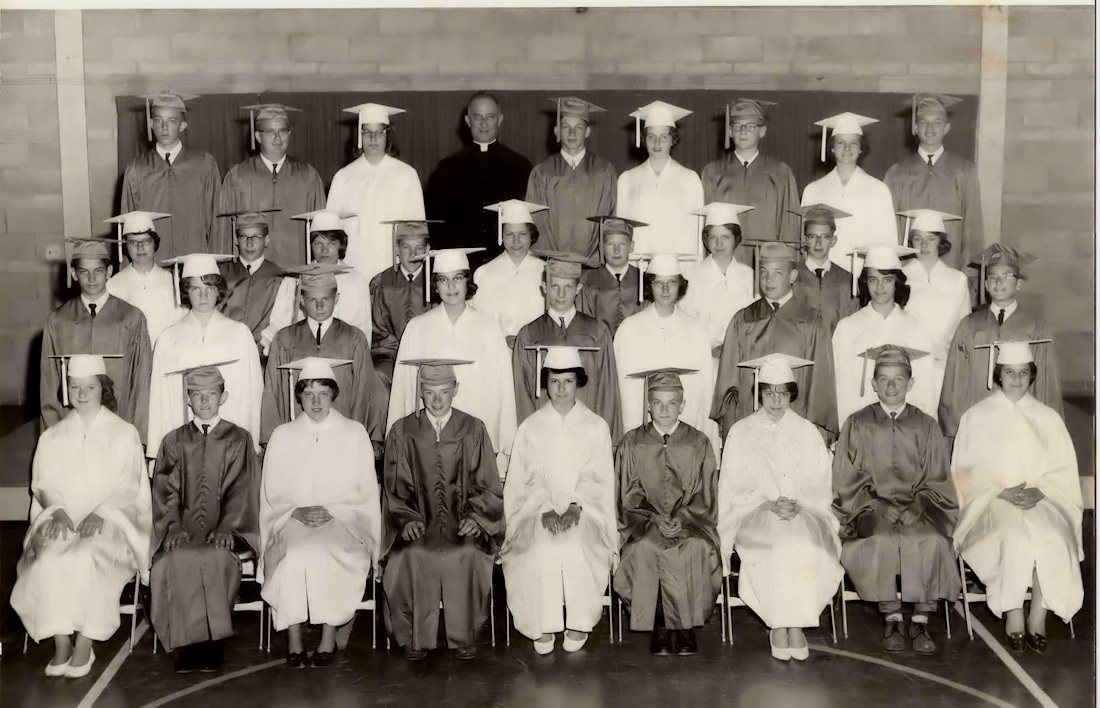 Things were very easy going our last year. We joked around
a bit, but the only prank I remember was some of us boys climbed up the church
bell tower and strung our ties together and hung them out the side of the tower.
It didn't last long because we had to retrieve our ties so we could wear them.
All through St. Mary's we had the uniform - a pale blue shirt and a dark
Navy Blue tie. The girls had dark blue jumper skirts and
they had to have a Peter Pan collar on their white blouse. The uniforms
were a great way to eliminate clothing competition among the kids.
Things were very easy going our last year. We joked around
a bit, but the only prank I remember was some of us boys climbed up the church
bell tower and strung our ties together and hung them out the side of the tower.
It didn't last long because we had to retrieve our ties so we could wear them.
All through St. Mary's we had the uniform - a pale blue shirt and a dark
Navy Blue tie. The girls had dark blue jumper skirts and
they had to have a Peter Pan collar on their white blouse. The uniforms
were a great way to eliminate clothing competition among the kids.
For years Dick Cahill, Pete Young and Jamie Hogan played basketball
every day at recess. There was only one hoop so I never played with them
- they were just too good. I had fun doing other things.
The boys joined the school basketball team that played in the Catholic school
league. I tried out for the team but I wasn't good enough. Besides
I had my paper route after school so I couldn't really stay late anyway.
All those years of playing together developed our team into the champions of
the league when we were in 8th grade, and our little school had to compete
with big schools in the City. Our guys were really good - and they went
on the be part of our High School team that became County Champions when I
was a Senior in High School. .I was really proud of my friends.
I believe 8th Grade was the year that Monsignor Daley gave us The Talk.
All the boys in the class got herded into one of the spare classrooms - (the
same one where I had been put to stop crying when I was First Grade).
Monsignor talked about resisting temptation, not to commit "self-abuse",
which was a terrible sin, and if we were tempted than we should go to the bathroom
(?). I had no idea what he was talking about. I wouldn't
hit puberty for another couple of years. After The Talk Larry Cummings
came up to me, his eyes were bugging out and he seemed frantic. "It's
a mortal sin to ---- ---!". I tried to be concerned
but I had a couple of years before I could start worrying about eternal damnation.
Apparently the girls got the girls' version of The Talk from the nuns
while we were being told to go to the bathroom. I could only speculate
what they were being told, other than to stay away from boys.
Some of our girls gave parties that were a lot of fun. I
think Karen Peach gave a party at her house, and we played Spin-the-Bottle
in her basement. Laurie Kelly tells me that party was where I was the
first boy that ever kissed her. Mary Adsit had a winter party
at her house. She lived in one of the beautiful big old houses in Baldwinsville
right by the river and her back yard sloped down to the river. We
had had hot chocolate and sleds and a toboggan and went sledding down the hill.
I got in the front of the toboggan and a bunch of kids piled on behind me and
we went down the hill. Sure enough we headed straight for a big bush
and rammed into it. The curved front of the toboggan got splintered, but I
escaped injury.
Later Peggy Ochs had a party. She had a very nice new suburban home.
We played records and danced in the dark, and that is where I remember hearing
Dionne Warwick sing "Don't Make Me Over" which I found very romantic
with its strings and choral singing.
Some years we had happy times at a School Picnic Day where the whole school
went to the park by the river in Baldwinsville and we had games and hot dogs.
It was great to see the Sisters joining us in our games.
It wasn't always about lessons and discipline. Our Sisters were people
too.
I still have the speech I gave when we graduated, written out in longhand,
with Sister Louis's red pen edits where she made a few corrections and added
some religious thoughts. It was very exciting and a little scary
thinking about going on to High School. Not all of my classmates would
be coming along with me - some of us decided to go to a brand new Catholic
High School - Bishop Ludden, which was expensive and required a long bus ride.
I was very happy to have many of my friends from St.Mary's along with
me in High School. At our 20-year High School reunion the St. Mary's
kids who were there got together for a group photo.
My brother Gary and my Sister Marilyn followed me to St. Mary's, and Gary
graduated one year after me, but Marilyn dropped out after 2nd or 3rd grade
because, unbeknownst to me, her Sister was giving her a very hard time.
Marilyn transferred to the new public grade school, Palmer Elementary, which
was in the country not far from Barbara Lane. All of my youngest siblings
then followed Marilyn in public school. Consequently Gary and I were
the only siblings to graduate from St. Mary's.
In 2002 our class had a 39-year reunion in Baldwinsville, where 21 of
the 35 graduates of the Class of 1963 were able to attend. It was wonderful
to see my friends and share memories together. Our reunion coincided
with the 50-Year Anniversary of the founding of our school, and we took a tour.
The school Principal was a Sister, but the teachers were now all civilians.
I imagine tuition must be expensive. When we were in school our Sisters
worked for the roof over their heads and for little more.
Poverty, Chastity, and Obedience. As I walked through the school,
I counted the desks in the classroom , and there were only 16 desks.
We had 35, sometimes more. The floors still had the original vinyl flooring,
polished. Everything was spotless. My friend Larry Cummings wondered
why I had tears streaming down my face.
In preparation for the Reunion I built a website for my class to help us locate
classmates and to share our experiences. It was a lot of fun putting
it together. I encourage the reader to visit http://www.webdatasystems.com/SMS63/
.
 I
was a student at St. Mary School (St. Mary's) from 1st grade through 8th Grade,
from which I entered High School. St. Mary's is a Catholic school associated
with St. Mary's Church, which is the Catholic Church for the parish in Baldwinsville,
New York.
I
was a student at St. Mary School (St. Mary's) from 1st grade through 8th Grade,
from which I entered High School. St. Mary's is a Catholic school associated
with St. Mary's Church, which is the Catholic Church for the parish in Baldwinsville,
New York. 









